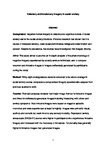Voluntary and Involuntary Imagery in Social Anxiety
| dc.contributor.author | Homer, Sophie | |
| dc.contributor.author | Deeprose, Catherine | |
| dc.date.accessioned | 2017-02-16T14:12:37Z | |
| dc.date.issued | 2017-02-16 | |
| dc.identifier.issn | 1352-4658 | |
| dc.identifier.issn | 1469-1833 | |
| dc.identifier.uri | http://hdl.handle.net/10026.1/8516 | |
| dc.description.abstract |
BACKGROUND: Negative mental imagery is ubiquitous in cognitive models of social anxiety and in the social anxiety literature. Previous research has shown that it is causal of increased anxiety, lower social performance ratings and lower implicit self-esteem. Despite its prevalence, few studies have investigated this imagery directly. AIMS: This study aimed to provide an in-depth analysis of the phenomenology of negative imagery experienced by socially anxious individuals, and to compare recurrent and intrusive images with images deliberately generated by participants during the study. METHOD: Thirty-eight undergraduate students screened to be above average in social anxiety scores completed a computerized imagery questionnaire adapted from previous qualitative work. RESULTS: Thematic analyses revealed four major image themes for intrusive images and three for deliberately generated images including interacting with others and anxiety symptoms. Most intrusive images were based on negative episodic memories and were experienced at least fortnightly. Images were primarily visual, auditory and somatic but could involve any sensory modality. Depression anxiety stress scale (DASS-21) scores were higher in participants who experienced intrusive imagery and increased with the frequency of intrusions. Emotionality was generally higher in intrusive images than generated images. CONCLUSIONS: The phenomenology of negative imagery experienced by socially anxious individuals is idiosyncratic and may be inherently different from images generated for use in experimental research. Theoretical and clinical implications are discussed. | |
| dc.format.extent | 1-15 | |
| dc.format.medium | Print-Electronic | |
| dc.language | en | |
| dc.language.iso | en | |
| dc.publisher | Cambridge University Press (CUP) | |
| dc.subject | Social anxiety | |
| dc.subject | intrusive imagery | |
| dc.subject | mental imagery | |
| dc.subject | qualitative | |
| dc.title | Voluntary and Involuntary Imagery in Social Anxiety | |
| dc.type | journal-article | |
| dc.type | Journal Article | |
| plymouth.author-url | https://www.ncbi.nlm.nih.gov/pubmed/28193311 | |
| plymouth.issue | 3 | |
| plymouth.volume | 45 | |
| plymouth.publication-status | Published online | |
| plymouth.journal | Behavioural and Cognitive Psychotherapy | |
| dc.identifier.doi | 10.1017/S1352465817000017 | |
| plymouth.organisational-group | /Plymouth | |
| plymouth.organisational-group | /Plymouth/Faculty of Health | |
| plymouth.organisational-group | /Plymouth/Faculty of Health/School of Psychology | |
| plymouth.organisational-group | /Plymouth/REF 2021 Researchers by UoA | |
| plymouth.organisational-group | /Plymouth/REF 2021 Researchers by UoA/UoA04 Psychology, Psychiatry and Neuroscience | |
| plymouth.organisational-group | /Plymouth/REF 2021 Researchers by UoA/UoA04 Psychology, Psychiatry and Neuroscience/UoA04 Psychology, Psychiatry and Neuroscience MANUAL | |
| plymouth.organisational-group | /Plymouth/Users by role | |
| plymouth.organisational-group | /Plymouth/Users by role/Academics | |
| dc.publisher.place | United States | |
| dcterms.dateAccepted | 2016-12-21 | |
| dc.rights.embargodate | 2018-2-16 | |
| dc.identifier.eissn | 1469-1833 | |
| dc.rights.embargoperiod | 12 months | |
| rioxxterms.versionofrecord | 10.1017/S1352465817000017 | |
| rioxxterms.licenseref.uri | http://www.rioxx.net/licenses/under-embargo-all-rights-reserved | |
| rioxxterms.licenseref.startdate | 2017-02-16 | |
| rioxxterms.type | Journal Article/Review |


